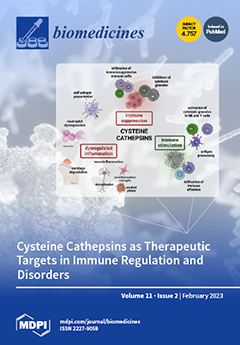The prevalence of non-alcoholic fatty liver disease (NAFLD) has soared globally. As our understanding of the disease grows, the role of the gut-liver axis (GLA) in NAFLD pathophysiology becomes more apparent. Hence, we focused mainly on the small intestinal area to explore the role of GLA. We looked at how multi-strain probiotics (MCP
® BCMC
® strains) containing six different
Lactobacillus and
Bifidobacterium species affected the small intestinal gut microbiota, inflammatory cytokines, and permeability in NAFLD patients. After six months of supplementation, biochemical blood analysis did not show any discernible alterations in either group. Five predominant phyla known as Actinobacteria, Proteobacteria, Firmicutes, Bacteroidota and Fusobacteria were found in NAFLD patients. The probiotics group demonstrated a significant cluster formation of microbiota composition through beta-diversity analysis (
p < 0.05). This group significantly reduced three unclassifiable species:
unclassified_Proteobacteria, unclassified_Streptococcus, and
unclassified_Stenotrophomonas. In contrast, the placebo group showed a significant increase in
Prevotella_melaninogenica and
Rothia_mucilaginosa, which were classified as pathogens. Real-time quantitative PCR analysis of small intestinal mucosal inflammatory cytokines revealed a significant decrease in IFN-γ (−7.9 ± 0.44,
p < 0.0001) and TNF-α (−0.96 ± 0.25,
p < 0.0033) in the probiotics group but an increase in IL-6 (12.79 ± 2.24,
p < 0.0001). In terms of small intestinal permeability analysis, the probiotics group, unfortunately, did not show any positive changes through ELISA analysis. Both probiotics and placebo groups exhibited a significant increase in the level of circulating zonulin (probiotics: 107.6 ng/mL ± 124.7,
p = 0.005 vs. placebo: 106.9 ng/mL ± 101.3,
p = 0.0002) and a significant decrease in circulating zonula occluden-1 (ZO-1) (probiotics: −34.51 ng/mL ± 18.38,
p < 0.0001 vs. placebo: −33.34 ng/mL ± 16.62,
p = 0.0001). The consumption of
Lactobacillus and
Bifidobacterium suggested the presence of a well-balanced gut microbiota composition. Probiotic supplementation improves dysbiosis in NAFLD patients. This eventually stabilised the expression of inflammatory cytokines and mucosal immune function. To summarise, more research on probiotic supplementation as a supplement to a healthy diet and lifestyle is required to address NAFLD and its underlying causes.
Full article






